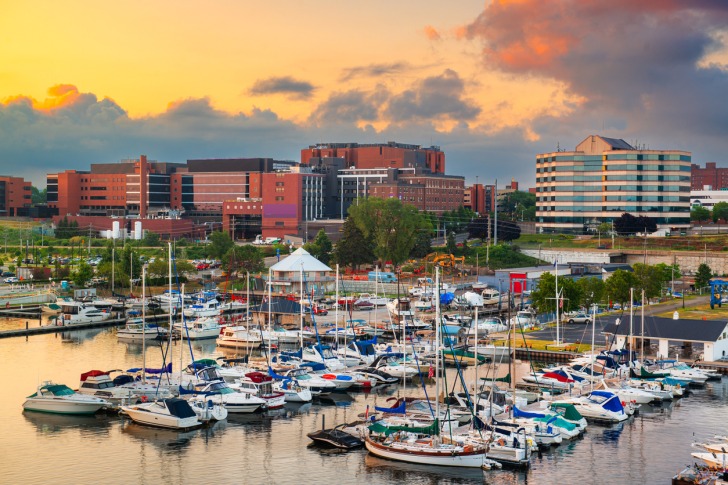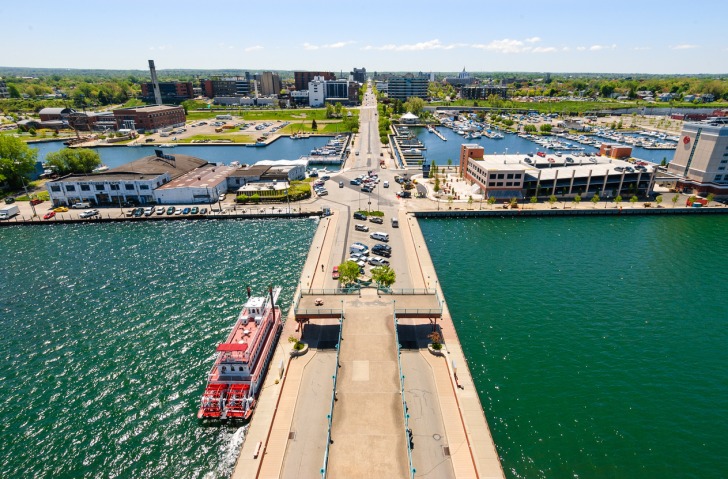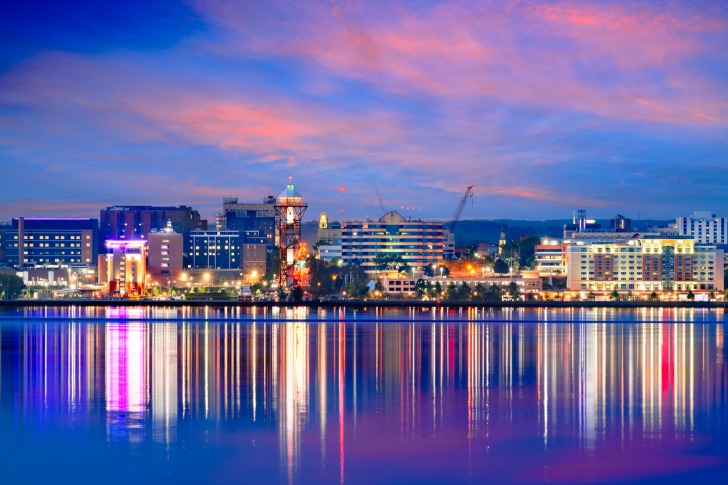Considering a move to Pennsylvania?
Erie could be the town for you.
The 5th largest city in the state, Erie’s scenic beauty, affordable cost of living, and old-fashioned vibe make it an appealing place to live.
Erie sits next to Lake Erie, which is open to swimming, kayaking, paddleboarding, canoeing, water skiing, tubing, and more!
There are pros and cons to living in Erie which you’ll have to weigh carefully to see if it’s a good spot for you.

Contents
Pros of Living in Erie, PA
Affordability is a major issue when looking for a place to live.
That’s one of Erie’s strong points.
If you move here, you can look forward to:
1. Low Cost of Living
Living in Erie will cost you 20% less than in other parts of the country.
Utilities, transport, food, healthcare, and housing are cheaper in Erie than in other major cities in the state.
The average home cost is about $164,000, significantly lower than the national average.
Affordable housing is a great incentive to make Erie your new home.
Housing options range from older, historic homes to modern dwellings and apartments.
2. Low Taxes
Compared to other Northern states, Pennsylvania has relatively low taxes.
Residents pay a 3.07% flat rate for income taxes which is lower than the U.S. average.
Erie residents are subject to a 1% local income tax to help support city services and infrastructure.
On top of that, there’s a 6% sales tax on manufactured goods bought in the city.
A low tax rate means more money in your pocket.
3. Educational Diversity
If you have a family, you’ll appreciate Erie’s educational diversity.
The city has 23 public schools and 40 private/parochial schools providing elementary through high school education.
After graduating from high school, students have various options for furthering their education.
There are 10 colleges and universities in the city alone, plus dozens more in the surrounding area.
Among these are Gannon University, Mercyhurst University, and Erie Institute of Technology.
4. Local Attractions
Presque Isle State Park is one of Erie’s most popular scenic attractions.
Its sandy beaches and picturesque trails attract thousands annually.
If you love history, you can check out the historical exhibits at the Erie Maritime Museum and Hagen History Center.
Art lovers will thrill over the expansive collection of modern and contemporary art at the Erie Art Museum.
Erie hosts a number of festivals annually including the Irish Festival and Food Truck Festival which offers delicious cuisine.
For additional entertainment, you can enjoy free music concerts at Liberty Park.
5. Good Transit System
If you don’t have a car, you can use Erie’s public transport system to navigate the city.
City buses travel from one end of town to the other, making it easy to get to local neighborhoods, the downtown district, and shopping malls.
You can easily commute to work or local hangouts by bus at affordable costs.
The layout and infrastructure of the city contribute to smooth, hassle-free travel.
To get to Buffalo, Pittsburgh, Cleveland, or other nearby cities, you can take Greyhound or Lakefront Bus Lines.
6. Location
Erie, PA is conveniently situated on Lake Erie’s southern shores.
It’s the only port in Pennsylvania that sits on a Great Lake.
Erie’s location makes it a convenient launching pad for day trips or weekend getaways into New England states.
A 2-hour drive from Erie gets you to Cleveland or Pittsburgh while Detroit and Toronto, Canada are only 4 hours away.
Vacation hotspots like Finger Lakes and Ithaca Falls are a mere 3 ½ hours away by car.
The city itself is a treasure trove of scenic beauty and cultural sites.
7. Outdoor Recreation
Erie is a virtual paradise for nature lovers and outdoor buffs.
During summer, you can enjoy beautiful sunset views of the lake from its sandy shores.
Lake Erie is a local hotspot for all kinds of water sports as well as soaking up the sun.
At Presque Island State Park, you’ll find over 20 miles of hiking and biking trails filled with wildlife to explore.
Frontier Park is a local favorite for picnicking and leisure activities with the family.
Hiking, communing with nature and birdwatching are favorite pastimes at Erie Bluffs State Park.
8. Family Friendly Environment
Erie’s kid-friendly environment is a good place to raise a family.
The city’s parks and beaches provide safe settings for recreational activities and family outings.
Sports fields and playgrounds are scattered around the city for exercise and fun.
The Erie Zoo and Children’s Museum are educational experiences your children won’t want to miss.
The city is also home to safe, clean family neighborhoods and excellent schools for your kids’ education.
Cons of Living in Erie, PA
Moving to Erie also has its drawbacks to include:
1. Extreme Winter Weather
There are four distinct seasons in Erie with winter being the worst.
Winters here are long and frigid with temperatures regularly dropping below freezing.
Erie receives, on average, 100 inches of snow annually, on top of regular thunderstorms, windstorms, fog, and ice.
Wind gusts can get up to 85 mph.
Warm winter clothing and a proper heating system in your home are essential for winter survival.
2. Weak Economy
Erie is still recovering from its post-COVID economic struggles.
The local economy and job market aren’t as strong as other metropolitan cities in the country.
Some of the main industries are plastic manufacturing, insurance, education, healthcare, and tourism.
Jobs in these industries, however, aren’t so readily found.
Future breakthroughs in the tech industry in this region could help stimulate the weak economy.
3. Pay Inequality
Pay inequality is yet another drawback of moving to Erie, PA.
Although there are people with high-paying jobs, most residents are struggling with low wages of $8 – $10 an hour.
Lack of training and skills limits employment options for many residents and reduces their chances of advancement.
Depending on your employer, entry-level salaries can vary greatly in Erie, from a high of $22.00 to a low of $6.60 hourly.
Statewide, Pennsylvania is known for paying some of the lowest wages in the country.
4. Poverty
Considering wage inequality, it’s not surprising that Erie has a problem with poverty.
The median yearly income in Erie is approximately $38,000, as compared to the national average of $65,700.
Approximately 26% of the population in Erie struggles with poverty.
This can be attributed to low earnings, a poor job market, and a weak economy.
5. Drugs
Addiction has impacted almost every major city in the country, but Erie has been hit particularly hard.
The widespread use of opioids has become a major crisis in the area.
Erie has been plagued with a high influx of heroin, methamphetamine, and fentanyl for years.
Between the years of 2019 and 2020, overdose incidents in Erie drastically increased by 196%.
During that same time, overdose deaths reached a record high.
6. Violent Crime
Although Erie’s overall crime rate isn’t bad, violent crime (murder, assault, etc.) has been steadily on the rise.
That’s not to say that the entire city is plagued by crime.
The East side, which is more impoverished, seems to be more dangerous than the West.
Erie as a whole is a safe place to live and raise a family.
By avoiding high-risk areas, you minimize your chances of being victimized by crime.
7. Population Decline
Over the last decade, Erie has experienced a 3-4% decline in its population as people gradually moved on.
This downward spiral in Erie’s population continues to date at a rate of about -0.68 annually.
From a recorded 94,639 population in 2020, Erie’s population dropped to 92,732 in 2023.
As a result, Erie’s status as the 4th largest city in Pennsylvania changed to being the 5th largest city in the state.
Population decline impacts a city’s federal funding, tax revenue, business income, and funding for city governance and schools.
8. Dilapidated Properties
Blighted (dilapidated) properties are apparently a big issue in Erie.
At one point there were over 500 abandoned, blighted buildings throughout the city.
Blighted properties pose a risk to the public due to their unsafe, unsanitary conditions.
When situated in quality neighborhoods, dilapidated buildings can reduce the neighborhoods’ esthetic appeal and property value.
Currently, city officials are making efforts to locate and recondition or demolish blighted properties to put the land to better use.

Pros and Cons of Living in Erie, PA – Summary Table
| Pros of Living in Erie, PA | Cons of Living in Erie, PA |
|---|---|
| 1. Low Cost of Living | 1. Extreme Winter Weather |
| 2. Low Taxes | 2. Weak Economy |
| 3. Educational Diversity | 3. Pay Inequality |
| 4. Local Attractions | 4. Poverty |
| 5. Good Transit System | 5. Drugs |
| 6. Location | 6. Violent Crime |
| 7. Outdoor Recreation | 7. Population Decline |
| 8. Family Friendly Environment | 8. Dilapidated Properties |
Frequently Asked Questions
Is it expensive to live in Erie, PA?
Erie, PA is an affordable city with a cost of living lower than the national average.
Low housing and rental costs help keep the cost of living down.
The cost of healthcare, utilities, transport, food, and other necessities is also less than in other major cities in the state.
Do you need a car to get around in Erie?
Erie’s public bus system provides efficient, comfortable services for intracity travel.
Bus routes extend to all areas of the city, making commutes easy and convenient for those who don’t own a car.
The city also provides bus services to other cities through private intercity bus lines.
Most residents, however, prefer having and using their own car.
Is Erie, PA a good place for families?
Erie has many safe, tight-knit communities that are perfect for raising a family.
The suburbs of Avonia, Fairview and Summit Township stand out for their quality schools and welcoming environment.
There are lots of green spaces for kids to play, beaches to enjoy, sports fields, a waterpark, a local zoo and other family-oriented attractions.
What’s there to see and do in Erie, PA?
Erie is home to both natural and cultural attractions like parks, lakes, museums, historical sites and art galleries.
Some of the most popular of these are Presque Isle State Park, the Erie Maritime Museum, Waldameer Park & Water World and the Tom Ridge Environmental Center.
Water sports like kayaking, paddleboarding, swimming, tubing and canoeing are favorite past times during summer.
Are there good colleges in Erie?
Erie is home to approximately 10 colleges and universities, with dozens more located within a 100-mile radius of the town.
Erie’s colleges serve approximately 20,000 students, offering Associates, Bachelor’s and Master degree programs.
Six of these institutions are private, three are public and one is a community college.











